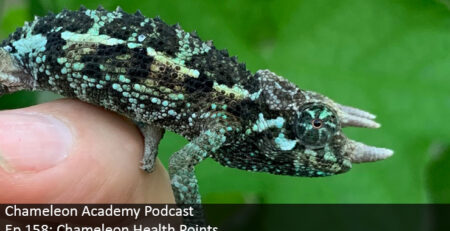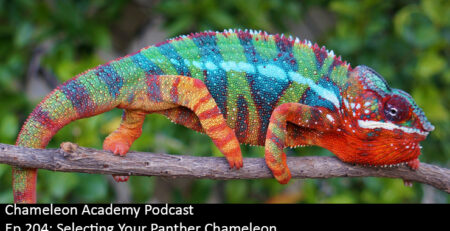Chameleons and their Colors
Chameleons are famous for changing color. As cool as it would be to change color to match a background, chameleon color change is much more useful to us. It gives us a window into what they are thinking. Chameleon colors change with age, temperature, and emotional state. Today I am going to talk about how chameleonS communicate through color and what it can do for our understanding of our mini tree dragon.
Podcast Player
Transcript (more or less)
Alright, folks, what is the thing chameleons are the most famous for? Wow, I have 436 votes for changing color and 400 of those are for changing color to match their background. And I am very sorry to burst that bubble because chameleons do not change color to match their background. I love chameleon history, but I, literally, have no idea where this came from. Someone somewhere decided it was a thing and it must of been a time before photographs or without a live chameleon in front of them because most chameleons are so different in color from their backgrounds that it requires someone without a live chameleon in front of them to think this is a good idea.
Now, I do need to make a differentiation here. There are two forces at work that we need to evaluate. The first is the natural palette of coloration that each chameleon has. That is the color ranges possible. See, chameleons cannot change any color of the rainbow they wish. There is a predetermined palette that they choose from and their color changes with respect to age, mood, temperature, and health. The second force, though, evolution, will have some effect on the palette the chameleon chooses from. There is one species, Trioceros laterispinis from Tanzania that has such a cryptic appearance that they blend perfectly into a lichen patch. Now that is definitely blending into the background! But that is evolution dictating their color palette. There is no judgment going on in the chameleon’s brain to control the colors and patterns with respect to the background. And if you take a Trioceros laterispinis and put it against a plain yellow background it will stand out like a sore thumb unable to change the genetically predetermined color and pattern.
This predetermined palette, though, has great diversity. In fact, one of the frustrating things for us lay people is how little color is taken into account when determining species by taxonomists. When I talk to Dr. Mark Scherz he gently explained to me how chameleons changing color combined with the natural variations in each individual chameleon made it an unreliable measurement. Of course, that drives us crazy as it is so obvious to us that this is a yellow flanked Jackson’s and that is a blue eyed Jackson’s!!! That is a yellow Parson’s chameleon and that is a blue Parson’s and that is a green Parson’s. Of course, if we were doing the species differentiation, there would be one huge species of Little Brown Chameleons! Obviously, I am joking as those of us undisciplined in the scientific method would create a different species for every extra scale shown. But the point of me going off on this winding road is to say that there is so much diversity in how chameleons show color that it is hard to find individuals that are exactly alike. The color palette can be wildly different between the different chameleon species. It can be drastically different between male and female. And you can see variations within a clutch of offspring. Color shown is a general characteristic of a species, but it is an individual trait.
UVB
Another thing I would like to bring up is that chameleons see beyond the spectrum we see. They see into the ultraviolet range and so they see Ultraviolet colors. What those are we can only imagine, but when scientists shone a black light on some chameleons the chameleons lit up. As beautiful as chameleons are to our eyes, to a chameleon’s eyes they are twice as colorful! And, realizing that chameleons see outside our vision ranges you start to wonder about species like the Meller’s Chameleon where we can’t figure out how to tell the difference between male and female. I wonder what the sexes look like outside the visible light spectrum. It may be boringly easy for chameleons to tell the difference.
This is all interesting and good, but what does this mean for us as chameleon keepers? Well, it is important that we understanding what we are seeing. Beyond being a fascinating part of what a chameleon is, colors can help us track how well our chameleon is doing. So, let’s dive into what we can tell by color.
The first aspect of color is age. Take a look at the most brightly colored panther chameleon or the most pleasant greens of the Jackson’s chameleon and you might be surprised to know that they both start off life as little brown and white slivers of cryptically colored wisps of a lizard. And this is because the entire world is out to eat them and they need that natural camouflage to help not be noticed. Veiled chameleons hatch as little green specs. Now, nature is hardly consistent. The babies of Trioceros deremensis hatch robin’s egg blue and then, after a couple weeks, fade into their greens. What purpose this has is unknown. But in all of this, chameleons have their baby colors that fade into their adult colors and this can tell us a good deal of how mature they are. Although this only works for the first 6 to 12 months of life. This is why experienced chameleon people will give you estimates on age up until about a year old and then you usually hear back that your chameleon is simply a sexually mature adult! This is important for you as a keeper to understand because if you buy a captive hatched chameleon from a breeder, what you get will, most likely, be a well started juvenile.
I remember I was selling carpet chameleon juveniles. They were little patterned green things. And I had a couple shut down the sale once they saw pictures of the baby because the expert boyfriend knew that carpet chameleon females were black with bright spots and so these weren’t what he was looking for. Their tone implied I was trying to pull one over on them. Well, in carpet chameleons that famous black comes only when a female is gravid. And not all gravid females get the black. And the juveniles wouldn’t show that coloration anyways. So, this was a very good sign for me to let those very book knowledgeable people go purchase from someone else. And this is going to be a common theme in this episode. The pictures in books and on the internet are often taken when a chameleon is at it’s most impressive to our human eyes. We like color and patterns and so pictures are often taken in the brief moments of life when the chameleon is in a high state of display. So, let’s go ahead and jump right into that!
Display Colors
If I had to pick one thing to communicate to the potential chameleon keeper about chameleon color it would be that most of the photos you see are taken when that chameleon is in a high display mode. Now, there are some species where this doesn’t make much difference. Jackson’s Chameleons look wonderfully green most of the time and high display may have a blueish tail, but things are relatively stable. Panther chameleons on the other hand can throw a first time keeper for a loop. The pictures that are used for marketing are when the male is fired up. This is when he is displaying to a female or, most likely, another male. Neither of which is normal for the beginning chameleon keeper to have laying around! And, this is why when people get their panthers home and they settle in the keeper wonders if the panther is sick because their colors are kind of dull. Well, at least when compared to the picture they used to purchase the chameleon! The female Furcifer minor, or Lesser Chameleon has an incredible display when she is gravid. And 99% of the pictures are taken during that month. The other months of the year she is a pleasant, nondescript, blink-and-you-miss-her green. I mean she has cute red armpits, but, other than that, you wouldn’t know you were looking at the same chameleon! And if you are expecting that dramatic gravid coloration you would be like my carpet chameleon customers so long ago – looking for something you won’t find. It is the same with the ubiquitous Veiled Chameleon. When the female is gravid and wants to warn off a male she becomes this striking black with yellow and blue spots. It is a sight to behold! And whenever I post a picture of mine in the gravid coloration I get a flood of messages asking how they can get a chameleon like that. When I post a normal colored female as she is the other 11 months out of the year I get all of zero messages asking how they can get one like that. And this is a common situation with many chameleon species. They color up to indicate a status and communicate. And it is only when you live with them day in and day out do you start getting a realistic view of what chameleon colors actually are and mean. And, if any panther chameleon breeders are listening there, it may help your customers to have a breeder profile page on your website for each male and female and post pictures from rest to display to sleeping to basking just to prep the customer to not be expecting the fireworks display colors 24/7!
And for the chameleon keeper, as much as we like seeing the display colors, we know that when we see those in every day life that that means we need to check around and see what is bothering our chameleon. It could be the ceiling fan was turned on, it could be a reflection somewhere, or it could be that one of those monster hornworms you lost in his cage crawled into sight. Those hornworms can be scary for chameleons until they know the worms are good to eat! Now, the display colors are just a part of the entire behavioral response to something and the intensity of the other behaviors can help you gauge the severity of what the chameleon sees. The puffed gular (that is the throat sac), the raised forearm, the inflated and flattened body, and, perhaps, the gaping mouth are all other aspects of the behavioral response to a threat. So, when you learn chameleon language you go from thinking a chameleon is a quiet little thing to realizing they shout out their feelings on a regular basis! And, boy, do we learn their personal views on life. Just wearing a red shirt can set them off. Or wearing a cap. Not only do some of these things turn you into a stranger, it seems certain colors are triggers for something deep into their lizard brain! But when you see your chameleon at home looking like the chameleon in the pictures that were used to sold him you know you need to figure out what is wrong! We want our chameleons to have resting awake colors!
Sleeping
Wait, “awake” colors? What’s with sleeping? Well, there is a favorite pastime in the community where we share pictures of our chameleons in their PJs. You see, when chameleons are asleep they relax all the color modulation. And surprise surprise, the resting sleeping state of a chameleon is actually some pretty dramatic colors! Which brings up an interesting realization. If the completely relaxed state of the skin is brightly colored, that means that the awake resting state is actually a result of active color modulation. Which, honestly, was a shock to me and I actually had to run it by a real PhD chameleon scientist to ask if I was missing something. This is quite interesting to me.
Photosensitive Skin
Now, when you go check on your chameleon in their sleeping colors you will see yet another fascinating aspect to chameleons. Their skin is photo sensitive! What? Yes, the skin will change color with light intensity. This is why, when searching for chameleons with flashlights in high trees at night that you have to keep your flashlight moving when you are trying to point out a chameleon. If you keep it in one place the chameleon may not wake up, but their skin will darken so they tend to disappear! And yes, you can create light and dark patterns on a chameleon by shining a flashlight on a stencil held by their side. You could do this, but I am not saying your chameleon will hold still for it or be amused in the least. So, this falls under the category of do it once if you have to just to get it out of your system, but I do not recommend putting together an act of stupid chameleon tricks!
Temperature
Another major use of color is when a chameleon is thermoregulating. It is simple physics that we can test ourselves. When we go out in the summer dressed in all black we are sweating more than if we go out in all white. This is because dark colors absorb light while white reflects light. Just as a side note, that is what colors are. It is just what wavelength of color is reflected back at your eyes. So a blue chameleon is absorbing all the colors except for blue. And that is a lot of light energy that is being absorbed. True black is absorbing all the light energy that hits it while true white is reflecting as much of the light energy that hits it. And the chameleon skin knows this. So when they are cold after a good night’s sleep and they want to warm up they lumber on over and plop themselves under the basking light. They darken their skin to absorb all the energy that they can so they can warm up quickly. Once they are warm they will revert back to their resting colors and go about their day. This is a normal part of their day. You would be right to assume it is the same on the other end. When they are too hot they will lighten their colors and be faded out. The difference is that this is not normal. If your chameleon is starting to fade out their colors it is time to cool them off immediately. A cold chameleon will slow down. A chameleon that is too hot will die. When heat stress starts to creep in it will start with their colors bleaching out. It will progress to gaping with their mouth open. And then the final stage before death is the eyes closing and sinking in. You hear me say over and over again that I want you to test what I say and verify it for yourself. This is one of the few cases where I implore you not to test it yourself. Trust that those are the stages and get your chameleon cooled off once you notice the skin noticeably lighter than usual. This is obvious when it is hot outside and you are right there with your chameleon sweltering. But this can happen when you are comfortable if you decided to put your chameleon out in the natural unfiltered sunlight. Inability to get away from the sun is deadly and since you are not in the cage, you will not be feeling it yourself.
Death approaches
There is another time you may see that sickly bleached out color is when the chameleon is near death. Unfortunately, this sickly bleaching could make some colors brighter and attractive. So it is deceptive. I had that experience when I was looking for a true blue nosy Be panther chameleon, It was hard to find the pure blue ones, but the regular nosy be’s can bleach out and be close to that blue. So just be careful. Usually, a chameleon on its death bed is not an attractive thing. But I was bitten by my inexperience and the deceit of an unscrupulous importer. You shouldn’t have to worry about death colors unless you really are scraping the bottom of the barrel to find cheap prices. And after seven years with your chameleon and getting to know his or her color personality you will know when the time is coming from many signs including color fade. Anyways, let’s get off this depressing subject!
Bruising.
There is a dramatic color that we can see in cases of injury. And that is pitch black. If there is bruising or internal damage the skin color will get very dark and even unmistakeable black. Sometimes this manifest as a sickly yellow. I saw a baby Bradypodion thamnobates that was, presumably, attacked by cage mates. The poor guy was a heartbreaking tapestry of yellow and black. A spider bite will give you black splotches across your chameleon as the chameleon deals with the poison.
Gravid Female
One thing we have already touched on is that females often put on quite a show when they are gravid and need to warn males away. Apparently, the chameleon world decided that this is the time that females needed bright colors. And, boy, do we get a show. Veiled Chameleons, carpet chameleons, panther chameleons, Lessor Chameleons, Furcifer campani, Furcifer labordi.,..the list is long of chameleons where the females are this nice pleasant hardly noticeable color until they need to tell a male to go bark up another tree.
Why Learn about Chameleon colors
Learning about color change in chameleons has two important purposes. The first is to become familiar with chameleons in order to manage expectations as to what to expect when your chameleon comes home with you. The second important thing is that monitoring the color status of your chameleon is an important part of your day to day observation. The most powerful early warning system that your chameleon’s health is threatened is your observation.
Watch your chameleon as they go through their life and get to know their behavior and color personality. Chameleons hide their illness very well. You know how people think chameleons drop dead suddenly? No, they take just as long to get sick and get sick seriously as any other animal. The difference is that they hide it for so long and you don’t notice it until it is too far gone to hide. So, your early warning system is observation. The people adept at this will be trigger by a feeling of something they can’t even take a picture of. But that early disturbance in the force is what will save the life of your chameleon. Chameleons respond to antibiotics and medication quite well in the early stages. You want to practice this and realize that when you get good enough at determining that something is off you may not get a whole lot of confirmation from the chameleon or from your vet. If you caught it early enough, the sickness is in the beginning stages and their adrenaline will allow it to muster up the energy to put on a show of force for the vet. You see, this is the time where your vet will not be able to confirm what you saw at home, but if your chameleon is strong enough to put on a show for the vet then your chances of recovery are excellent. So, yes, you need to have the trust of your vet that you have made a good judgement and a good observation and get the treatment without waiting for the chameleon to get so far gone that it can’t help but to show its weakness. Unfortunately, that may mean that it may be too late. One great strategy is to take pictures of your chameleon showing signs of sickness at home so your vet can see what you are seeing. You know how your computer starts working as soon as the IT guy comes by to see what the problem is? Or when the noise while you drive just doesn’t repeat when the mechanic is doing the treat drive? Well, that is the exact situation when you bring your chameleon to the vet. If the illness is not advanced, the vet will only get sass.
Color change is one aspect of the critical behavior guidelines that will serve as your early warning system. It is maintained by daily observation and you becoming an expert on the quirks and personality of your chameleon
Conclusion
And with that I hope you feel much more confident in interpreting what you may encounter being a chameleon keeper. I am glad you are here and doing your research into how to better care for your chameleon. I am having a fun time putting this show together. If you would like to see some behind the scenes talk and discussion about the future of the Chameleon Academy I would love to have you join the Chameleon Academy Patreon. Support there helps what I do out here! And I want to give a big thanks to those of you already part of the Chameleon Academy Patreon group. And, thank you for joining me on this enjoyable journey learning about those incredible chameleons. This is Bill Strand signing off, and I will see you next time.












